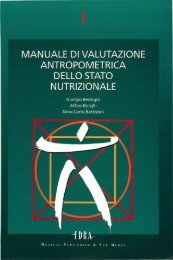Body Mass Index: From Quételet to Evidence ... - Giorgio Bedogni
Body Mass Index: From Quételet to Evidence ... - Giorgio Bedogni
Body Mass Index: From Quételet to Evidence ... - Giorgio Bedogni
You also want an ePaper? Increase the reach of your titles
YUMPU automatically turns print PDFs into web optimized ePapers that Google loves.
2<br />
<strong>Giorgio</strong> <strong>Bedogni</strong>, Claudio Tiribelli and Stefano Bellentani<br />
<strong>Quételet</strong>’ s <strong>Index</strong><br />
The ratio of body weight <strong>to</strong> squared stature (W/S 2 ), nowadays known as the body mass<br />
index (BMI), was proposed as a measure of body shape by the Belgian anthropologist<br />
Adolphe <strong>Quételet</strong> in the late 19 th century [1-4]. W/S 2 was then just one of the many indexes<br />
used by anthropologists <strong>to</strong> control body weight for stature, i.e. <strong>to</strong> measure body shape [5], and<br />
was the option preferred by <strong>Quételet</strong> for adults [2, 3]. Of the plethora of weight-stature<br />
indexes developed in the last two hundred years [5], W/S 2 is however the only one still in use<br />
<strong>to</strong>day. Surprisingly, it is also the only one not <strong>to</strong> be remembered with the name of its inven<strong>to</strong>r<br />
[3, 5]. Even if <strong>Quételet</strong> did not use W/S 2 as an adiposity or prognostic index as we do <strong>to</strong>day,<br />
the lack of acknowledgement for its discovery is surprising in view of the immense<br />
contributions given by this man <strong>to</strong> the fields of anthropology and statistics (not <strong>to</strong> mention<br />
sociology and astronomy) [2, 4, 6]. For instance, by showing that the heights of French<br />
conscripts and the chest circumferences of Scottish soldiers tended <strong>to</strong> be normally distributed,<br />
<strong>Quételet</strong> made the fundamental discovery that the normal curve could be used other than an<br />
error law applied <strong>to</strong> the movements of planets. He literally brought the normal curve from the<br />
skies <strong>to</strong> the earth, in the hope of building a new science of man [1]. This finding was central<br />
<strong>to</strong> the development of both anthropometry and statistics. Thus, even if W/S 2 is not used <strong>to</strong>day<br />
as it was by <strong>Quételet</strong>, we should always recall the great contributions of its inven<strong>to</strong>r <strong>to</strong><br />
anthropometry when using “his” index [3].<br />
<strong>Body</strong> <strong>Mass</strong> <strong>Index</strong> as an <strong>Index</strong> of Adiposity<br />
W/S 2 might have been one of the many forgotten weight-stature indexes if it had not been<br />
rediscovered as an index of adiposity more than one hundred years after its introduction. The<br />
demonstration of an association between W/S 2 and body fat gave a new life <strong>to</strong> <strong>Quételet</strong>’ s<br />
index and the new name of BMI [5, 7-10]. As a demonstration of the success encountered by<br />
W/S 2 , the term “body mass index” entered the Medical Subject Heading of the National<br />
Library of Medicine in 1990. Here, BMI is defined as “one of anthropometric measures of<br />
body mass; it has the highest correlations with skinfolds and body density”. This definition<br />
reflects the fact that skinfolds [11] and body densi<strong>to</strong>metry [12] were used <strong>to</strong> measure body fat<br />
in the first validation studies of BMI.<br />
The search for anthropometric indexes of adiposity has been fuelled by the hypothesis<br />
that excess body fat could be a risk fac<strong>to</strong>r for chronic disease [13]. Due <strong>to</strong> its simplicity, BMI<br />
offered the opportunity <strong>to</strong> study the relationship between body fat and disease in population<br />
studies. However, even if BMI is associated with fat-free tissues less than other weightstature<br />
indexes [5, 13], its numera<strong>to</strong>r (weight) is the sum of fat and fat-free tissues so that<br />
BMI cannot be considered a pure index of adiposity (Figure 1). It should also be noted that,<br />
while the association of BMI with morbidity and mortality is now very clear (see next<br />
paragraph), only recently the association between body fat and chronic disease started <strong>to</strong> be<br />
investigated. The measurement of body fat requires in fact methods that are difficult <strong>to</strong> use in




